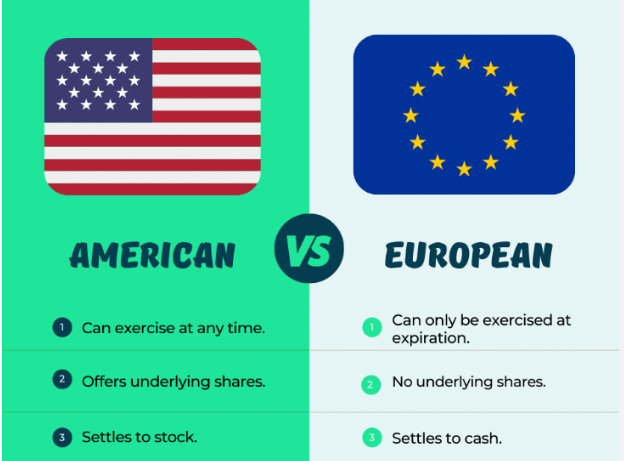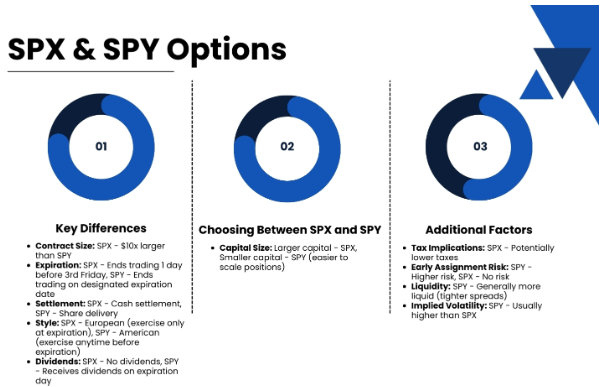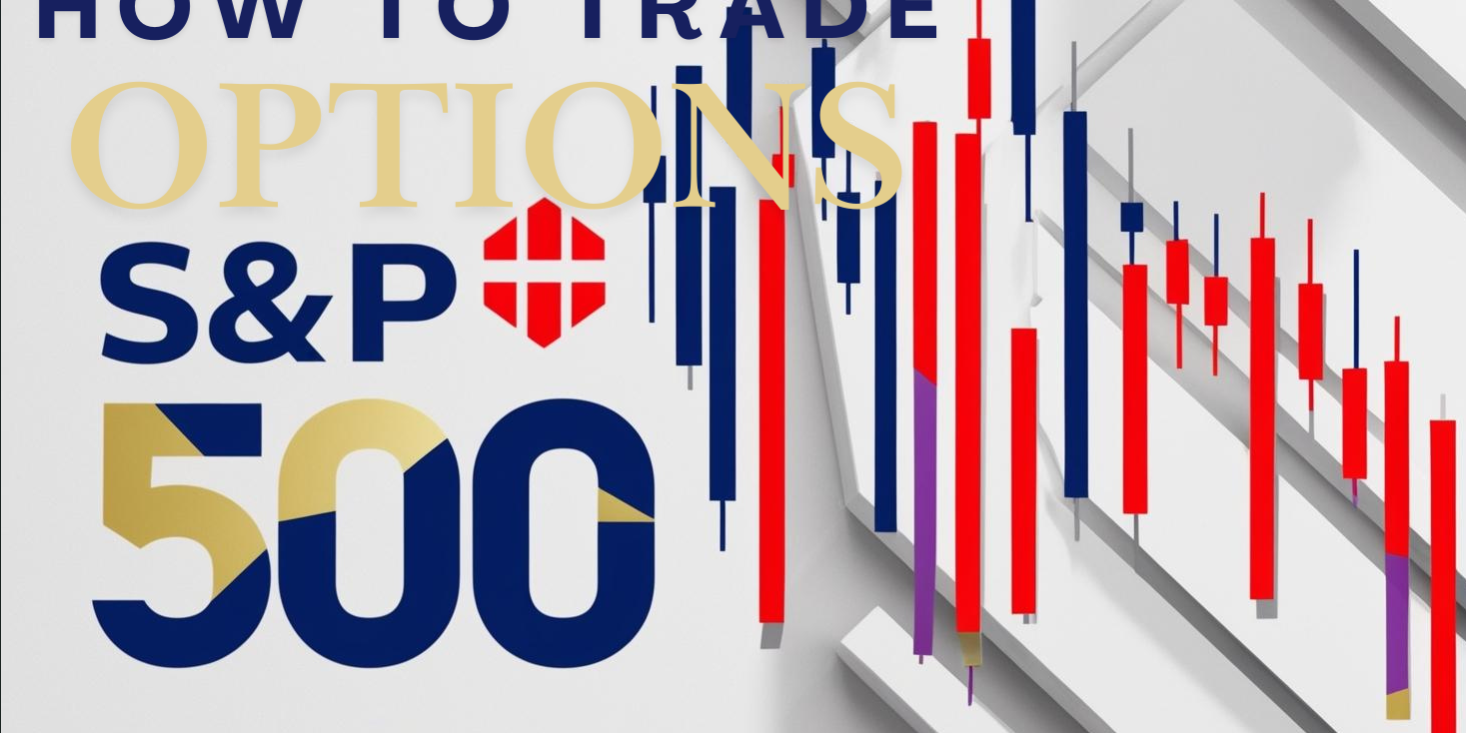How to Trade SPX Options – Ultimate Guide
Trading SPX options provides investors with an exciting and dynamic way to participate in the stock market’s movements, offering distinct advantages that can significantly enhance your trading strategies.
Imagine being able to leverage market volatility, hedge against downturns, and generate consistent income—all with one versatile trading instrument. SPX options make this possible by allowing you to speculate on the broader market movements represented by the S&P 500 Index.
This powerful trading vehicle opens up opportunities for substantial profits, flexible risk management, and advantageous tax treatment, making it a compelling choice for both new and seasoned traders.
In this comprehensive guide, you’ll uncover everything you need to know about trading SPX options effectively. We’ll dive deep into understanding the SPX options chain, clarify critical differences between SPX and ETF-based options like SPY, and reveal insights on trading venues and broker availability. Additionally, we’ll share strategies and tactics from experts to help you maximize profitability and ensure robust portfolio protection.
By the end of this guide, you’ll be fully equipped to trade SPX options confidently and strategically. We’ll simplify complex topics and provide practical tips, enabling you to make informed decisions that align with your trading goals and enhance your overall market performance.
What is an SPX Option?
An SPX option is a financial derivative based on the S&P 500 Index, allowing investors to speculate on or hedge against the overall performance of the U.S. stock market by using the index as the underlying asset. These options grant the holder the right, but not the obligation, to receive a cash settlement equivalent to the difference between the index’s value and the option’s strike price upon expiration.
Unlike options on individual stocks, SPX options are European-style, meaning they can only be exercised at expiration, and are cash-settled, eliminating the need for physical delivery of underlying assets.

American-style vs European-style options
Brief History of Options Trading
The concept of options trading dates back to ancient times. Financial instruments have been used throughout history to manage risk and speculate on future prices. One of the earliest recorded instances involves the Greek philosopher Thales of Miletus, who, anticipating a bountiful olive harvest, secured the rights to use olive presses in advance at a fixed price, profiting when demand soared.
In the 17th century, options trading became more structured in the Amsterdam stock exchange, where contracts were used to speculate on the prices of tulip bulbs during the infamous Tulip Mania. The modern era of options trading was significantly advanced with the establishment of the Chicago Board Options Exchange (CBOE) in 1973, introducing standardized contracts and fostering a more transparent and liquid market
Can You Buy Options on the S&P 500?
Yes, traders can buy options on the S&P 500 through SPX options, providing exposure to market-wide movements. These options let investors participate in or hedge against broad market fluctuations without needing to purchase shares of individual companies.
SPX options offer significant leverage, enabling investors to amplify potential returns while carefully managing risk. For instance, traders can buy call options to speculate on bullish market expectations or put options as a safeguard against potential downturns.
Purchasing S&P 500 options allows traders to benefit from movements in a broad market index without owning individual stocks, making it an efficient and cost-effective approach. Whether investors seek short-term profits or portfolio protection, SPX options present an accessible and liquid solution.
Their cash-settled nature further simplifies the process by eliminating the complexities associated with physical delivery, streamlining risk management, and ensuring smooth execution at settlement.
What is the Symbol for the S&P 500 Options?
The symbol for S&P 500 options is SPX. SPX represents the index itself, and options derived from this symbol follow its movement. Traders utilize the SPX symbol to easily identify options that directly reflect the performance of the 500 large-cap stocks composing the index. This simplified identification aids in quickly accessing option chains, analyzing market sentiment, and executing trades efficiently.
SPX options differ from ETF options, such as those on SPY, in that they are index-based, settled in cash, and European-style. Traders often prefer SPX options over ETF alternatives because of their advantageous tax treatment, broad market exposure, and liquidity, which is clearly identified and accessed via the SPX symbol. This standardized symbol allows traders to rapidly engage with the market, ensuring seamless entry and exit points during active trading periods.
Benefits of Trading SPX Options vs. SPY Options

Differences between SPX & SPY Options
Trading SPX options offers distinct advantages over trading options on the SPY ETF, including favorable tax treatment, greater leverage, cash settlement, and European-style expiration.
SPX options receive favorable tax treatment as index options under IRS Section 1256, wherein gains are subject to 60% long-term and 40% short-term capital gains rates, potentially reducing tax liability compared to the short-term capital gains treatment typically applicable to SPY ETF options.
Additionally, SPX options are cash-settled, eliminating concerns about share delivery or assignment. SPY options, conversely, involve physical delivery, requiring traders to manage potential early assignments or maintain sufficient capital to purchase or deliver shares.
SPX options also feature European-style expiration, meaning options cannot be exercised early. This eliminates the uncertainty of early assignment risks, enabling traders to plan strategies with greater confidence and predictability. SPY options, following American-style expiration, carry risks of early exercise, particularly around dividend payments.
Furthermore, SPX options provide significant leverage, allowing investors to control larger notional positions with less capital compared to SPY options. SPX’s higher notional value is ideal for traders seeking enhanced leverage, precise portfolio hedging, and capital-efficient speculation.
Understanding these benefits allows investors to make informed decisions, strategically choosing between SPX and SPY based on their specific trading style, goals, and risk management requirements.
| Ready to elevate your trading potential with SPX options? Take the next step by booking a call with a Maverick Trading expert today. Our specialists will help you develop a tailored trading plan designed to maximize profitability and effectively manage your portfolio risk. Start trading smarter, achieving your financial goals with confidence and clarity. |
Can You Buy SPX Directly?
Investors cannot directly buy or sell shares of the SPX index because it is a statistical measure rather than a tradable asset. However, traders can indirectly gain exposure to the index through various financial instruments, including options and futures. SPX options provide a flexible, leveraged method for participating in the index’s performance. By trading SPX options, investors can effectively speculate on or hedge against broad market movements without needing to purchase individual stocks or ETFs.
SPX options are cash-settled, meaning they don’t involve the delivery of shares. Instead, the difference between the strike price and the index’s closing value at expiration determines the payout. This unique structure makes SPX options a highly efficient way for investors to capitalize on their market views or manage portfolio risk without investing directly in the underlying equities.
For direct stock-like exposure, traders typically use ETFs such as SPY, which track the S&P 500 closely and allow for direct trading in shares. However, SPX options offer distinct advantages in flexibility, tax treatment, and liquidity, making them a popular choice among experienced traders seeking to optimize their investment strategies.
What Exchange Are SPX Options Traded On?
SPX options are traded exclusively on the Chicago Board Options Exchange (CBOE), which is the largest U.S. options exchange and a global leader in trading and innovation. The CBOE specializes in index options, equity options, and volatility products (e.g. CBOE Volatility Index), and is known for its robust liquidity, transparency, and efficiency.
SPX options are particularly attractive due to the high volume and significant open interest that the CBOE consistently provides, ensuring traders have ample opportunities to enter and exit positions quickly and at favorable prices.
Trading SPX options on the CBOE provides distinct benefits, including excellent liquidity and narrower bid-ask spreads compared to less popular exchanges or products. This liquidity facilitates faster trade executions, reduces transaction costs, and enhances overall trading efficiency. Additionally, the CBOE supports extended trading hours for SPX options, allowing investors to respond rapidly to market-moving events and global economic developments outside standard U.S. market hours.
As a central marketplace for SPX options, the CBOE offers a comprehensive and transparent platform for trading, significantly reducing counterparty risk and streamlining the settlement process through its efficient cash-settlement procedures. Traders benefit from reliable execution, deep liquidity, and advanced trading tools, making SPX options an essential part of many professional traders’ and institutional investors’ portfolios.
Can I Trade SPX Options on Robinhood?
Currently, Robinhood does not support trading of SPX options. While Robinhood provides access to equity options, ETF options, and cryptocurrency trading, index options such as SPX are not available on the platform. Investors interested in trading SPX options will need to consider other brokerage platforms offering this capability.
The absence of SPX options trading on Robinhood may influence traders who prioritize comprehensive access to market instruments. Robinhood’s simplified interface and commission-free trading model appeal strongly to new and casual investors; however, experienced traders often prefer platforms offering more diverse trading options, such as SPX. This limitation highlights the importance of selecting a brokerage aligned with one’s trading needs and strategic goals.
Traders interested in SPX options may choose alternative brokerages such as TD Ameritrade, Charles Schwab, Interactive Brokers, or E*TRADE, all of which offer robust platforms, extensive research tools, and the capability to trade SPX and other index options efficiently and effectively.
What Broker Allows You to Trade SPX?
Several brokerage platforms allow investors to trade SPX options, providing extensive functionality, analysis tools, and support. Some of the most popular platforms include Interactive Brokers, TD Ameritrade’s thinkorswim, Charles Schwab, E*TRADE, Fidelity, and Interactive Brokers.
Interactive Brokers (IB) is a prominent brokerage platform that facilitates trading of SPX options, offering a range of advantages that make it a favored choice among professional traders and institutions. Maverick Trading, for instance, has utilized IB’s services for over two decades, benefiting from its comprehensive offerings.
Advantages of Using Interactive Brokers for SPX Options Trading
- Extended Trading Hours: IB provides access to extended global trading hours for SPX options, allowing traders to manage risk and execute strategies nearly 24 hours a day, five days a week. This flexibility is crucial for responding to global market events and economic developments outside regular trading sessions. interactivebrokers.com
- Capital Efficiency: Trading SPX options through IB can offer capital efficiency benefits. The platform’s margin requirements and interest structures are designed to optimize the use of capital, potentially allowing traders to maintain more flexible and cost-effective positions. Reddit
- Advanced Trading Tools: IB offers sophisticated trading platforms equipped with advanced analytical tools, real-time data, and customizable interfaces. These features enable traders to implement complex strategies and make informed decisions based on comprehensive market analysis.
- Competitive Pricing: IB is known for its low commission rates and transparent fee structures, which can significantly reduce trading costs over time. This cost-effectiveness is particularly beneficial for active traders engaging in high-frequency trading strategies.
These advantages, coupled with IB’s longstanding reputation for reliability and innovation, make it a preferred broker for trading SPX options among experienced traders and institutions.
TD Ameritrade’s thinkorswim is a favorite among traders due to its sophisticated analytical tools, customizable charting, and extensive educational resources. It supports advanced trading strategies and real-time data analysis, making it ideal for both beginners and professional traders. Charles Schwab, which now owns TD Ameritrade, similarly offers robust tools and seamless integration with multiple trading platforms.
E*TRADE is another well-known brokerage, recognized for user-friendly interfaces, comprehensive educational resources, and reliable execution. Fidelity offers competitive pricing and robust customer support, appealing to both new and seasoned investors. Interactive Brokers stands out for its professional-grade tools, low fees, international market access, and high-quality execution.
Choosing the right broker to trade SPX options depends on your trading style, strategy requirements, and desired level of platform sophistication. Evaluate factors such as ease of use, commission structure, available analytical tools, reliability, and customer support to select the platform that best aligns with your trading objectives.
What is an SPX Options Chain and How to Read It?
An SPX options chain provides a detailed list of all available call and put options for the S&P 500 Index, organized by expiration dates and strike prices. Understanding how to read an options chain is essential for making informed trading decisions. The SPX options chain typically includes essential details such as bid and ask prices, strike prices, expiration dates, implied volatility, and open interest.
Strike price
The strike price represents the price at which the underlying index can be theoretically bought (call) or sold (put). Bid and ask prices indicate the highest price buyers are willing to pay and the lowest price sellers are willing to accept, respectively. This spread helps traders determine market liquidity and potential trading costs.
Expiration dates
Expiration dates represent the time frame within which an option contract is valid. Traders select expiration dates based on their market predictions, risk management strategies, and profit objectives. Short-term expirations offer higher risk and reward, while long-term expirations provide greater stability.
Implied volatility (IV)
Implied volatility (IV) reflects the market’s expectation of future price movements. Higher implied volatility suggests a greater expectation of market swings, potentially increasing the option’s premium.
Open Interest
Open interest indicates the total number of outstanding option contracts, reflecting liquidity and market interest in a specific option.
Analyzing these elements within an SPX options chain allows traders to identify suitable options contracts aligning with their market outlook and risk tolerance. By carefully examining this information, investors can optimize their trading strategies, efficiently manage risk, and enhance potential returns.
What if I Invested $1000 in S&P 500 10 Years Ago?
 Investing $1,000 in the S&P 500 ten years ago would have resulted in significant growth due to the index’s robust historical performance. Over the past decade, the S&P 500 delivered an average annual return of approximately 10-12%, driven by strong economic growth, corporate earnings, and favorable market conditions.
Investing $1,000 in the S&P 500 ten years ago would have resulted in significant growth due to the index’s robust historical performance. Over the past decade, the S&P 500 delivered an average annual return of approximately 10-12%, driven by strong economic growth, corporate earnings, and favorable market conditions.
If you had invested $1,000 in the S&P 500 ten years ago, your investment would have grown to approximately $2,590 to $3,100, excluding dividends reinvested. With dividends reinvested, your returns would be even greater, highlighting the power of compound growth and consistent long-term investment.
This growth underscores the importance of consistent, long-term investment strategies. While past performance does not guarantee future results, historical data consistently illustrates the long-term wealth-building potential of the S&P 500. Investors using SPX options can further enhance returns by leveraging strategic positions to capitalize on shorter-term market movements, hedging risks, or generating income through option premiums.
Understanding historical market performance and leveraging this knowledge through informed trading can significantly enhance overall portfolio outcomes, underscoring why SPX options remain an attractive investment tool.
Conclusion
Trading SPX options offers unique opportunities to strategically enhance returns, manage risk, and diversify your investment portfolio. Throughout this guide, we have explored what SPX options are, how to trade them effectively, and the distinct advantages they offer compared to alternatives like SPY options.
Understanding the specifics of SPX options, including their trading venues, brokerage requirements, and how to interpret the SPX options chain, equips you with the knowledge to capitalize on market opportunities effectively.
The tax advantages, cash settlement, leverage potential, and predictability provided by SPX options offer powerful incentives for traders to incorporate these instruments into their investment strategies. Whether you’re aiming to hedge a portfolio against market volatility, generate consistent income, or speculate on market direction, SPX options provide flexibility and strategic depth unmatched by other investment tools.
As you integrate SPX options into your trading strategy, remember the importance of selecting the right brokerage, thoroughly analyzing options chains, and consistently leveraging market insights. To further enhance your SPX options trading proficiency, explore our additional resources, such as “Top 5 Strategies to Maximize Profit with SPX Index Options” and our guide on “How to Use SPX Options for Market Hedging and Portfolio Protection.”
Ready to elevate your trading potential with SPX options? Take the next step by booking a call with a Maverick Trading expert today. Our specialists will help you develop a tailored trading plan designed to maximize profitability and effectively manage your portfolio risk. Start trading smarter, achieving your financial goals with confidence and clarity.




